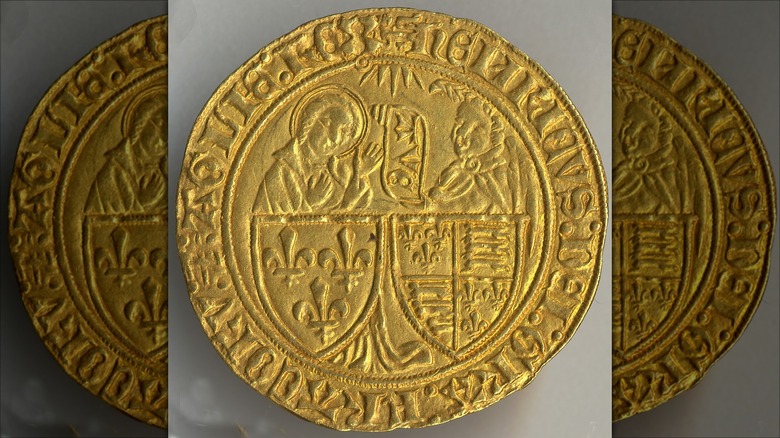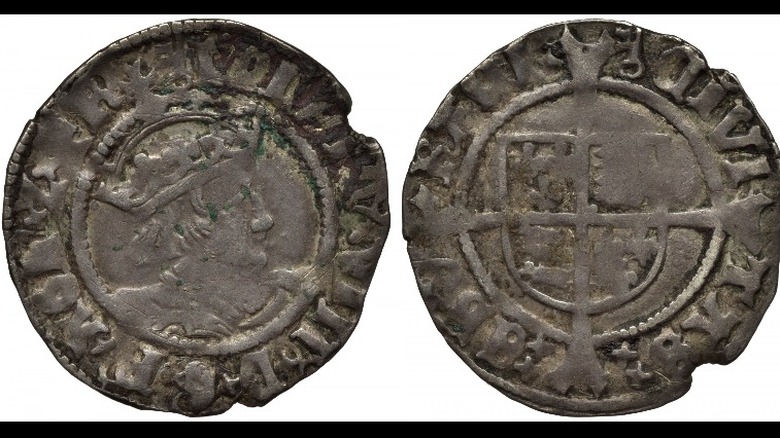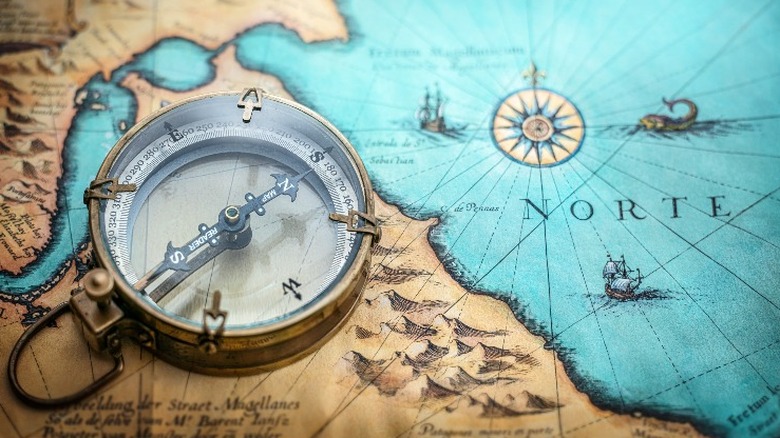A Centuries-Old Coin Could Change What We Know About European Contact With North America
Edward Hynes' metal detecting hobby was relatively new — and he wasn't expecting to find much of anything — when he made a remarkable discovery.
He was exploring the southern coast of Newfoundland, Canada this summer when his detector signaled the presence of metal, and he found a gold object about five inches underground. He wasn't sure what the small, shiny object was, but he noticed it had a fleur-de-lys, a shield, and a Latin inscription on it. After he posted a picture of it in a metal detecting Facebook group, someone theorized it might be a medieval English coin (via Salt Wire).
Paul Berry, former curator of the Bank of Canada's Currency Museum, was later able to confirm this: The object was a Henry VI quarter noble (example pictured). It would've been minted in London between 1422 and 1427, making it the oldest English coin ever found in Canada, per CNN.
Hynes was obligated to turn the coin over to the provincial government because of a law giving the province ownership of found artifacts, according to Salt Wire. The coin will probably eventually go on display at The Rooms museum in St. John's, Newfoundland.
Ancient coins in Newfoundland
Though Newfoundland's government released a statement about the discovery, they aren't saying exactly where Hynes found the coin, just that it's near an archaeological site (via Salt Wire). No one is quite sure how the coin got there. According to CNN, Berry believes it was probably already out of circulation before its owner lost it.
When it was made, the coin had a high value, around 1 shilling, 8 pence, which would be equivalent to 61 American dollars or 81 Canadian dollars today.
Newfoundland has a rich archaeological history, and this isn't the first rare coin to have been found there. The previous oldest known English coin found in Canada was discovered last year at the Cupids Cove Plantation Provincial Historic Site. It was a silver Henry VII half groat (equal to two pence), minted in Canterbury, England, between 1493 and 1499 (example pictured). The government of Newfoundland and Labrador noted in their press release that this coin "would have been in circulation for at least 111 years before it was lost" — meaning they think it came to Canada with English settlers at the time of colonization. Newfoundland became England's first New World possession in 1583.
Possible European contact
Despite that theory, others believe there may have been contact between Europeans and Native Americans before 16th-century colonization, but after the known Viking contact more than 1,000 years ago. CNN notes numerous stories told by Europeans about strange, far-off lands, including one from England's Channel Islands about a lost ship in the 15th century landing in a place with an abundance of fish.
Portugal has a similar legend about Bacallao or the Terra de Bacalhau (the land of codfish). This island west of the Azores was depicted on Portuguese maps and charts in the 16th century, but mentioned elsewhere even earlier. Chronicler Gaspar Frutuoso credited the island's discovery to the 15th-century explorer João Vaz Corte-Real. Frutuoso's work isn't considered very reliable, but another chronicler, Bartolomé de Las Casas, also wrote about Portuguese exploration of Bacallao. Newfoundland itself may hold proof of the mysterious land's existence: There's an island off the province's Avalon Peninsula called Baccalao (via Linguazza).
The Henry VI coin found by Hynes dates to the same period as these stories about the land of fish. If it was lost when it was fairly new, that would mean English people — or people who'd traveled through England — arrived in Newfoundland at least 70 years earlier than previously believed, and certainly before Christopher Columbus' arrival in America. Jamie Brake, an archaeologist who helped identify the coin, acknowledged that a European presence in Newfoundland between the Vikings and the 16th century settlement is certainly possible.


